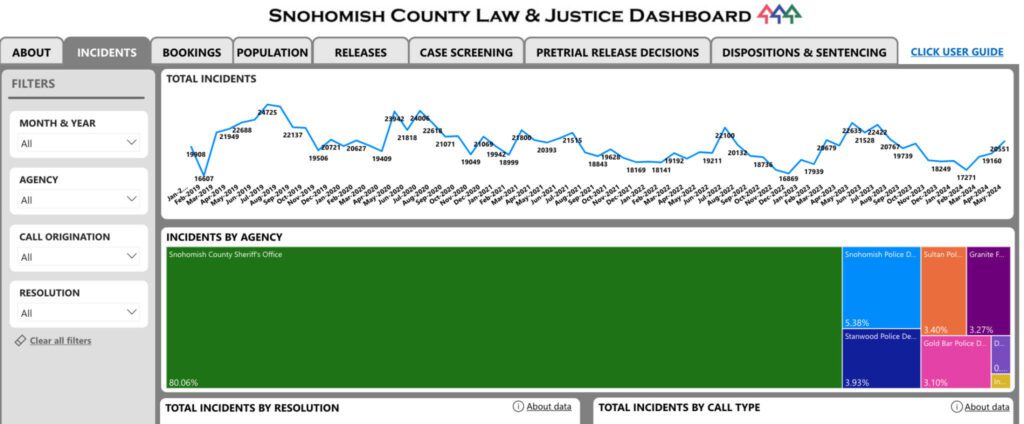EVERETT — How many people did Snohomish County sheriff’s deputies arrest last year?
How many calls did Stanwood police respond to?
How many people pleaded guilty to felony charges?
How many were acquitted?
These questions and others can now be answered in the county’s new Law and Justice Dashboard, a public database of crime statistics collected by the Snohomish County Sheriff’s Office and the Prosecuting Attorney’s Office. Launched Tuesday, former Prosecutor Adam Cornell first proposed the project after George Floyd’s murder in 2020.
Originally, the hope was to make the database public by October 2022.
The current prosecutor, Jason Cummings, hopes the data can give the public and lawmakers a better understanding of the criminal justice system.
“Important in this dashboard is identifying areas that raise questions,” Cummings wrote in an email Tuesday. “So that we can have conversations on a policy level about why there may be a disparity or why a given number is observed.”
The initiative received funding through a Microsoft grant to City University of New York’s Institute for State and Local Governance, nearly 3,000 miles east of Snohomish County. In a press release, Microsoft’s Justice Reform Initiative Lead Kevin Miller called the dashboard an “important step” in the advancement of the county’s legal system.
Starting at January 2019, the database gives a sweeping overview of the county’s criminal justice system: reported incidents, arrests, jail bookings, jail population, prosecution and sentencing. Data can be organized by race, gender and age.
What’s missing?
Many police statistics from any city in the county, except those that contract with the sheriff’s office. On Tuesday, Cummings acknowledged the limitations of the data, stating the gap was partly due to data permissions. He hopes to bring other cities “on board” for future versions of the dashboard, but wanted to get it online now.
Incident reports to the sheriff’s office have stayed largely consistent over the past five years, according to the database.
In January 2019, when the data begins, the sheriff’s office documented 19,908 incidents.
In May 2024, there were 20,551.
The month of July 2020 saw the most incidents: 24,006.
The database also shows fluctuation in bookings the daily population in the Snohomish County Jail amid pandemic restrictions in 2020. January 2019 saw the highest number of bookings, at 1,769, before dipping to a low of 835 in April 2020.
Since then, bookings have averaged between 1,000 and 1,500 per month. Last month, officers booked 1,422 people into jail — bringing the inmate count to the highest daily average since the pandemic began, at 685.
Because the jail is run by the sheriff’s office, it does give a glimpse into some city police data, when it comes to arrests. Everett police made roughly 20.63% of all jail bookings, with the sheriff’s office right behind at 19.98%.
The database reveals how the pandemic affected the jail: It had an average daily population of 764 in February 2020, decreasing to 312 by May 2020. Since then, the population has steadily risen.
Last month, the jail reported an average daily population of 685 inmates. Cummings attributed the increase to “rebounding” from pandemic-era booking restrictions.
In January 2019, officers referred 1,204 cases to the prosecutor’s office, the highest amount in the past five years, according to the data. The least was in August 2021, at 664. Last month, officers referred 822 cases.
The database also gives data from the Snohomish County courthouse, showing 12,793 defendants pleaded guilty to charges, with another 584 found guilty at trial, since 2019. Juries acquitted 245 defendants. Prosecutors dismissed more than 7,600 cases, and were somewhat more likely to dismiss a misdemeanor charge.
Judges sentenced most defendants to jail or prison with suspended time. A Drug Offender Sentencing Alternative, available for defendants struggling with substance abuse, was the least likely sentence judges gave.
Cummings hopes the database can continue to advance for years to come.
“While this was a long process to get to this point, we always have room for improvement and every time the Dashboard is presented, we get the chance to learn how it can be improved,” Cummings wrote.
Maya Tizon: 425-339-3434; maya.tizon@heraldnet.com; Twitter: @mayatizon.
Talk to us
> Give us your news tips.
> Send us a letter to the editor.
> More Herald contact information.


























